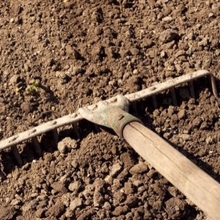The primary nutrients N, P and K are those that soil needs in large quantities. The secondary macronutrients (nutrients plants need in smaller quantities) are calcium, silicon, magnesium and sulfur. In reality, plants need sulfur in about the same quantity as phosphorus, but sulfur is still considered a secondary nutrient. (There is a third group of nutritional minerals, which the soil needs only in trace amounts, hence the name “trace minerals.”)
Enough of the secondary nutrients (calcium, silicon magnesium and sulfur) are often found in soils, avoiding the need to add them in fertilizers. Calcium and magnesium are almost always added as a byproduct of the process liming to raise the pH. That’s because many alkaline (lime) compounds contain calcium and magnesium compounds. If an application to raise soil pH is done by applying gypsum, the sulfur in soil is also raised. Strangely enough, increased soil levels of sulfur have the effect of lowering pH, although that is not the best way to lower pH.
In its pure elemental form, sulfur is an attractive bright yellow crystal, sought after by rockhounds (thumbnail photo at the top). Industrial usage of sulfur is largely in the form of sulfuric acid used for phosphate ore extraction.[1] Before the cleanup of airborne industrial waste products, it was not uncommon to see a yellow haze over large cities with sulfur-producing facilities. It is this atmospheric sulfur carried by rain that settles on soils to provide sulfur to plants.
 |
| Sulfur mining in Canada |
Sulfur, in addition to elemental sulfur, is found as sulfides and sulfates. The unpleasant odor of rotten eggs and sewage is from hydrogen sulfide; the odor given off by burning matches is sulfur dioxide. Sulfur in the soil is generally in a sulfate form, and microbes change it to sulfide compounds that enter the soil solution and can be taken up by plant roots for growth. The bacterial process of changing sulfur to compound forms plants can use renders it a slow-release fertilizer, which is oxidized for use over the growing season. An “instant” absorbable compound is Epsom salts (magnesium sulfate), adding both sulfur and magnesium. (Epsom salts is named after a town in England, Epsom, where it was discovered.)
Actually, soils get sulfur from three sources: airborne particles, the weathering of minerals in soils, and microbial activity. Sulfur conversion by microbes happens in soil containing large amounts of decomposing organic materials like green manures, animal wastes (including urine), insects, worms, and dead microbes. Grass clippings contain atmospheric sulfur and should also be added back to the soil. Some soil sulfur occurs naturally from the weathering process of minerals.
In some circumstances like sandy soils, the sulfur in soil solution can leach into our water systems. In water-logged soils, sulfur can be converted by microbial activity into a gas, and escape into the atmosphere. Soil sulfur can also react/bond with iron and become insoluble.
 |
| Sulfur deficiency (left) |
Generally speaking, sulfur is usually not a problem in the soils, and a plant sulfur deficiency is somewhat rare. (However, brassicas such as canola, broccoli and cabbages require sulfur fertilization for maximum crop yields.)
Endnotes
[1] http://en.wikipedia.org/wiki/Sulfur
[2] http://www.ces.ncsu.edu/plymouth/cropsci/graphics/sulfur2.jpg
Photo Credits
A sulfur crystal (Thumbnail), Smithsonian Institution, Public Domain
Large sulfur pile in Canada, licensed under Creative Commons ShareAlike 1.0
Sulfur deficiency in plants, http://www.ces.ncsu.edu/plymouth/cropsci/graphics/sulfur2.jpg
Other Soil-Related Articles
Plants need calcium, too
Microbes in Soil
Brix? Good soil!
Biochar (Carbon)
Weeds!!! (as soil indicators)
Understanding Soil Testing
Rock Dust…DUH!!
Nitrogen
Potassium
Phosphorus
















